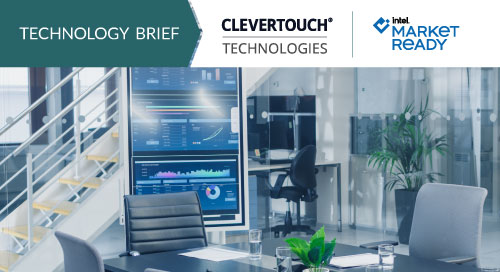Digital Displays Enrich the Hybrid Workplace Experience

“I’m so excited to go into the office and sit in a conference room,” said no employee ever. Yet, the digital transformation of the workplace has focused primarily on facilitating meetings. While Microsoft Teams, Zoom, and Webex effectively connect distributed teams, the modern workplace needs more than video conferencing. Today’s offices need solutions that engage employees even before they enter the building.
“It’s been proven that employees can be productive when working from home,” says Mark Tildesley, Enterprise Director for Clevertouch Technologies, a provider of digital display screens and smart space technology. “So when you go to the office, it needs to be an occasion, and a place for collaboration. You want employees to say, ‘I’m excited I’m going to the office today.’”
Meeting technology is foundational, providing equity, but it’s merely the base. “You should expect to push a button and have it work without any issues,” says Tildesley. “It’s like getting excited because your lights work.”
Organizations can and should do more to bring offices alive, engaging coworkers to connect across devices. The challenge is that companies often don’t know where to start. They want better hybrid workplaces, but they aren’t aware of what’s possible.
“Henry Ford said if he had asked people what they wanted, they’d have said faster horses,” says Tildesley. “Companies are in this same situation. That’s where the technology supplier and the integrator come in. The end user of the technology isn’t the IT manager and it’s not the CEO; it’s the people at the desks. We ask, ‘What do you want them to do? Be more creative? More productive? More efficient? How do you want to support them when they’re together in the building?’”
Innovation Starts with Digital Display Screens
To energize its workforce, a large UK retailer deployed Clevertouch Solutions for Cloud and PC in its offices and operations centers. The company came to Clevertouch because they wanted a simple-to-use one-touch meeting room. “That’s what they thought they wanted,” says Tildesley. “We said, ‘we can build that, but let’s talk about what else you might want in your workplace and how else you might want employees to work.’”
Clevertouch deployed smart spaces that connect the company’s entire building with digital signage, creating a more energizing and productive environment (Video 1). In the reception area, LED video wall displays greet employees and guests with vibrant branding content. Visitors check in at a 10-inch touch screen that captures their information. Signage kiosks offer QR codes that send wayfinding information to smart phones. Employees can check work and meeting space availability from their own devices, book a desk or room, and host virtual meeting attendees on dual displays. Intelligent environmental sensors allow users to adjust the room temperature. The IT team can send alerts and information to all connected devices. And users can order lunch or coffee.
The #SinglePlatform solution connects the company’s head office, operation centers, and #retail environments. @myClevertouch via @insightdottech
The single platform solution connects the company’s head office, operation centers, and retail environments. “If you worked in one of their stores and you had to go to the operation center, you knew how the tech worked,” says Tildesley.
Creating Smart Spaces of the Future
Clevertouch leverages the partnership ecosystem to reimagine what’s possible. The company uses DisplayNote and Logitech Inc technology to put together end-to-end scalable systems that can evolve and grow, serving different functions as a company’s needs and objectives shift. Systems are loaded with Clevertouch Live, the company’s signage software platform that supports and connects all devices. And digital display screens run on Intel® Open Pluggable Specification (Intel® OPS) processors that standardize the system architecture.
“Using Intel OPS allows us and our partners to say to the end user, ‘How do you really want to work? You don’t just have meetings 10 hours a day, what else do you want to do in that room?’” says Tildesley. “We bring the meeting room to life the rest of the day, and Intel is an incredibly important part of that.”
Tildesley predicts that the workplace of the future will be potentially unrecognizable from today’s offices. “People are rushing to create a modern workplace and they’ve still got rows of cubicles,” he says. “Fundamentally, it’s the same as an office was 30 years ago. I think the workers aren’t going to want to work in that environment. Work isn’t where you go, work is what you do. People want to go to somewhere they can collaborate and be creative. The office should be an exciting destination with more and more automation of basic tasks. And the tech itself should merely be a means to an end.”